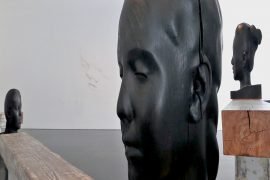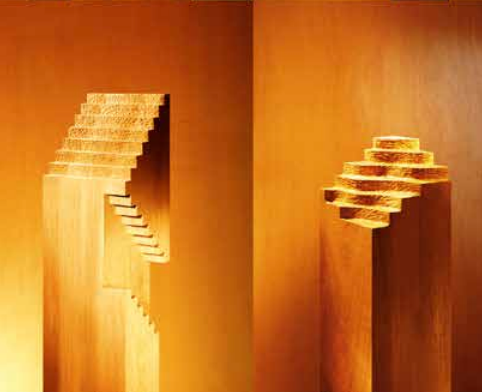
Sorigué Foundation promotes various programs to make effective a "return...

Ramon Espel has been Construction Manager at the Sagrada Família...

In 2018 it was 100 years since Egon Schiele’s death....

The 13th edition of Barcelona Design Week On 5 opens...

More than 150 works, including paintings and documents, show the...

One of the most unknown aspects of one of today’s...

Visiting the Colonia Güell today is to get to know...

The success of the exhibition that the Macba has devoted...

"Geometry of Light" is not just an artistic intervention. Created...

The image of a skyscraper-free Barcelona is part of a...

Música clásica sobre la arena de la playa en dos...

The first session of the cycle on the regatta organized...

The hospital's managing director, Manel del Castillo, and the pharmaceutical...

Generalitat y Ayuntamiento impulsarán dos equipamientos de 'Casa de les...

Leticia Beleta, director of Alexion Pharmaceuticals in Spain and Portugal,...

We all have a friend who never leaves the Gràcia...

Barcelona director opts for Best International Film with 'La sociedad...

The hotel and industrial sectors softened the market's decline last...

The technology company, with a workforce of 35 employees and...

“The women of yesteryear were strong and had to fight...

[dropcap letter=”T”]
he ramp is nature’s reinterpretation; the stairway, an invention. If a perfect horizontal plane is something artificial – i.e. a creation –, then a succession of horizontal planes uniformly distributed both in depth and height – i.e. the stairway – is a remarkable invention. An invention that, unlike the wheel, is found or disseminated all over the globe, with an ecumenical leading role since time immemorial. Ever since the earliest Egyptian monuments, the stairway has been an architectural piece reluctant to improvements for many millennia. And, from its inception, the stairway has been a construction filled with symbolism of many different kinds: power, hierarchy, mystical or erotic.
The stairway conceived as a symbol for either rise to heaven or descent to hell has been lost in time despite its stubborn presence in practically every single culture. Yet another commonly known symbol for the stairway is that of a phallic erection as well as the ideal stage of erotically loaded representations. I am not referring exclusively to the celebrity star scantly clad coming down with sexual parsimony the long Folies Bergère stairway, but to a Claudia Cardinale dressed with a white bathrobe, majestically and stunningly walking down the Girl with a Suitcase stairway.
Nearly every memorable historical stairway play two distinguishing roles. The first one, the handrail horror. Regardless of whether artists represent stairways in a drawing or a painting, or that stage designers build them or even architects build them for daily use, creators have always decided to design stairways without handrails, without any protection whatsoever, without the presence of the irritating diagonal handrail, with its steps displayed in its highest purity. The ensuing risk and discomfort for users is blatant, but the insistence of the executor to neglect this nuisance is no less. In painted stairways, from Leonardo’s Adoration of the Magi to Duchamp’s Nude Descending a Staircase, the absence of handrail is a common denominator. In cinema footage, this is also the case: How many swordsman’s duels in stairways with a handrail can we recall? How many stairways with handrails were present in German expressionism? How many handrails have we witnessed in musicals by Busby Berkeley or Robert Leonard?
The second common trait in every stairway made in history is the current regulation’s illegal status. Just like fire alarms safety measures, stairways of this kind would not be authorized for construction nowadays. It seems that legislators do not share the architect’s love for stairways. It is undeniable that, in case of fire, the gap in the stairways serves as a chimney, which would make it unusable for an escape route. However, there is an undeniable risk caused by a regulation that penalizes stairways in a rude manner. Stairways cannot be built in outdoor locations but its access is only restricted to places with automatic doors, which require titanic force to be opened and that are, usually, illegally nonetheless logically, wedge stopped. In addition, stairways have been banned on a variety of designs, e.g. curved shapes, progressive dimension steps, flying steps, etcetera. Therefore, legislators claim that a stairway, like the magnificent one in Palais Garnier Opera, that fails to comply with all rules, is very dangerous and would lead to multiple tragic falls, although the exact number of deaths caused by this public enemy for the past century and a half remains unknown.
Unsurprisingly, exhausted from this growing pressure, we, architects, and disappointed with this lost sterile battle in search of alternative projects, have opted for adapting to widely-accepted solutions and sticking to regulations: the straight and enclosed stairway with equally-sized and orthogonal steps; the overused and universal standard stairway design that is inexpensive and safe. We have gone from considering it as the central part of the building to display it as a utility room. If we pretend to design stairways such as the ones made in the past, they would be deemed as illegal as an escape route, which means that we will need to convince the customer to finance it as a mere decorative sculpture.
This is the primary reason why I consider that this protagonist of classical architecture is an endangered species. This is so because currently the stairway has stopped from being the pezzo di bravura for the architect to become a mere service space, a purely functional, isolated, marginal, and almost standardized element. I am pessimistic about the future of the stairway as a noble architectural theme, and this prediction saddens me because throughout my career I have had a lot of fun building some of them and throughout my life I have enjoyed climbing them up and down, and I am even considering the idea of writing a travel guide based in these pleasure-giving generators.

[dropcap letter=”T”]
he ramp is nature’s reinterpretation; the stairway, an invention. If a perfect horizontal plane is something artificial – i.e. a creation –, then a succession of horizontal planes uniformly distributed both in depth and height – i.e. the stairway – is a remarkable invention. An invention that, unlike the wheel, is found or disseminated all over the globe, with an ecumenical leading role since time immemorial. Ever since the earliest Egyptian monuments, the stairway has been an architectural piece reluctant to improvements for many millennia. And, from its inception, the stairway has been a construction filled with symbolism of many different kinds: power, hierarchy, mystical or erotic.
The stairway conceived as a symbol for either rise to heaven or descent to hell has been lost in time despite its stubborn presence in practically every single culture. Yet another commonly known symbol for the stairway is that of a phallic erection as well as the ideal stage of erotically loaded representations. I am not referring exclusively to the celebrity star scantly clad coming down with sexual parsimony the long Folies Bergère stairway, but to a Claudia Cardinale dressed with a white bathrobe, majestically and stunningly walking down the Girl with a Suitcase stairway.
Nearly every memorable historical stairway play two distinguishing roles. The first one, the handrail horror. Regardless of whether artists represent stairways in a drawing or a painting, or that stage designers build them or even architects build them for daily use, creators have always decided to design stairways without handrails, without any protection whatsoever, without the presence of the irritating diagonal handrail, with its steps displayed in its highest purity. The ensuing risk and discomfort for users is blatant, but the insistence of the executor to neglect this nuisance is no less. In painted stairways, from Leonardo’s Adoration of the Magi to Duchamp’s Nude Descending a Staircase, the absence of handrail is a common denominator. In cinema footage, this is also the case: How many swordsman’s duels in stairways with a handrail can we recall? How many stairways with handrails were present in German expressionism? How many handrails have we witnessed in musicals by Busby Berkeley or Robert Leonard?
The second common trait in every stairway made in history is the current regulation’s illegal status. Just like fire alarms safety measures, stairways of this kind would not be authorized for construction nowadays. It seems that legislators do not share the architect’s love for stairways. It is undeniable that, in case of fire, the gap in the stairways serves as a chimney, which would make it unusable for an escape route. However, there is an undeniable risk caused by a regulation that penalizes stairways in a rude manner. Stairways cannot be built in outdoor locations but its access is only restricted to places with automatic doors, which require titanic force to be opened and that are, usually, illegally nonetheless logically, wedge stopped. In addition, stairways have been banned on a variety of designs, e.g. curved shapes, progressive dimension steps, flying steps, etcetera. Therefore, legislators claim that a stairway, like the magnificent one in Palais Garnier Opera, that fails to comply with all rules, is very dangerous and would lead to multiple tragic falls, although the exact number of deaths caused by this public enemy for the past century and a half remains unknown.
Unsurprisingly, exhausted from this growing pressure, we, architects, and disappointed with this lost sterile battle in search of alternative projects, have opted for adapting to widely-accepted solutions and sticking to regulations: the straight and enclosed stairway with equally-sized and orthogonal steps; the overused and universal standard stairway design that is inexpensive and safe. We have gone from considering it as the central part of the building to display it as a utility room. If we pretend to design stairways such as the ones made in the past, they would be deemed as illegal as an escape route, which means that we will need to convince the customer to finance it as a mere decorative sculpture.
This is the primary reason why I consider that this protagonist of classical architecture is an endangered species. This is so because currently the stairway has stopped from being the pezzo di bravura for the architect to become a mere service space, a purely functional, isolated, marginal, and almost standardized element. I am pessimistic about the future of the stairway as a noble architectural theme, and this prediction saddens me because throughout my career I have had a lot of fun building some of them and throughout my life I have enjoyed climbing them up and down, and I am even considering the idea of writing a travel guide based in these pleasure-giving generators.
